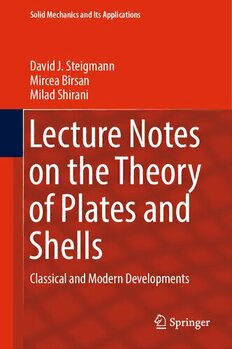
Lecture Notes on the Theory of Plates and Shells: Classical and Modern Developments PDF
Preview Lecture Notes on the Theory of Plates and Shells: Classical and Modern Developments
Solid Mechanics and Its Applications David J. Steigmann Mircea Bîrsan Milad Shirani Lecture Notes on the Theory of Plates and Shells Classical and Modern Developments Solid Mechanics and Its Applications FoundingEditor G.M.L.Gladwell Volume 274 SeriesEditors J.R.Barber,DepartmentofMechanicalEngineering,UniversityofMichigan,Ann Arbor,MI,USA AndersKlarbring,MechanicalEngineering,LinköpingUniversity,Linköping, Sweden Thefundamentalquestionsarisinginmechanicsare:Why?,How?,andHowmuch? Theaimofthisseriesistoprovidelucidaccountswrittenbyauthoritativeresearchers givingvisionandinsightinansweringthesequestionsonthesubjectofmechanics as it relates to solids. The scope of the series covers the entire spectrum of solid mechanics.Thusitincludesthefoundationofmechanics;variationalformulations; computational mechanics; statics, kinematics and dynamics of rigid and elastic bodies;vibrationsofsolidsandstructures;dynamicalsystemsandchaos;thetheo- ries of elasticity, plasticity and viscoelasticity; composite materials; rods, beams, shells and membranes; structural control and stability; soils, rocks and geome- chanics; fracture; tribology; experimental mechanics; biomechanics and machine design. The median level of presentation is the first year graduate student. Some textsaremonographsdefiningthecurrentstateofthefield;othersareaccessibleto finalyearundergraduates;butessentiallytheemphasisisonreadabilityandclarity. Springer and Professors Barber and Klarbring welcome book ideas from authors.Potentialauthorswhowishtosubmitabookproposalshouldcontact Dr.MayraCastro,SeniorEditor,SpringerHeidelberg,Germany,email:mayra. [email protected] IndexedbySCOPUS,EiCompendex,EBSCODiscoveryService,OCLC,ProQuest Summon,GoogleScholarandSpringerLink. · · David J. Steigmann Mircea Bîrsan Milad Shirani Lecture Notes on the Theory of Plates and Shells Classical and Modern Developments DavidJ.Steigmann MirceaBîrsan DepartmentofMechanicalEngineering FacultyofMathematics UniversityofCalifornia UniversityDuisburg-Essen Berkeley,CA,USA Essen,Germany DepartmentofMathematics MiladShirani DepartmentofMechanicalEngineering University“AlexandruIoanCuza”ofIas,i UniversityofCalifornia Ias,i,Romania Berkeley,CA,USA ISSN 0925-0042 ISSN 2214-7764 (electronic) SolidMechanicsandItsApplications ISBN 978-3-031-25673-8 ISBN 978-3-031-25674-5 (eBook) https://doi.org/10.1007/978-3-031-25674-5 ©TheEditor(s)(ifapplicable)andTheAuthor(s),underexclusivelicensetoSpringerNature SwitzerlandAG2023 Thisworkissubjecttocopyright.AllrightsaresolelyandexclusivelylicensedbythePublisher,whether thewholeorpartofthematerialisconcerned,specificallytherightsoftranslation,reprinting,reuse ofillustrations,recitation,broadcasting,reproductiononmicrofilmsorinanyotherphysicalway,and transmissionorinformationstorageandretrieval,electronicadaptation,computersoftware,orbysimilar ordissimilarmethodologynowknownorhereafterdeveloped. Theuseofgeneraldescriptivenames,registerednames,trademarks,servicemarks,etc.inthispublication doesnotimply,evenintheabsenceofaspecificstatement,thatsuchnamesareexemptfromtherelevant protectivelawsandregulationsandthereforefreeforgeneraluse. Thepublisher,theauthors,andtheeditorsaresafetoassumethattheadviceandinformationinthisbook arebelievedtobetrueandaccurateatthedateofpublication.Neitherthepublishernortheauthorsor theeditorsgiveawarranty,expressedorimplied,withrespecttothematerialcontainedhereinorforany errorsoromissionsthatmayhavebeenmade.Thepublisherremainsneutralwithregardtojurisdictional claimsinpublishedmapsandinstitutionalaffiliations. ThisSpringerimprintispublishedbytheregisteredcompanySpringerNatureSwitzerlandAG Theregisteredcompanyaddressis:Gewerbestrasse11,6330Cham,Switzerland Preface The theory of plates and shells originated in the need on the part of engineers for tractablemodelstoanalyzeandpredicttheresponseofthinstructurestovariouskinds ofloading.Thebasicideaistoexploitthethinnessofthestructuretorepresentthe mechanicsoftheactualthinthree-dimensionalbodyunderconsiderationbyamore tractable two-dimensional theory associated with an interior surface. In this way, therelativelycomplexthree-dimensionalcontinuummechanicsofthethinbodyis replacedbyafarmoretractabletwo-dimensionaltheory.Toensurethattheresulting model is predictive, it is necessary to compensate for this ‘dimension reduction’ byassigningadditionalkinematicalanddynamicaldescriptorstothesurfacewhose deformations are modeled by the simpler two-dimensional theory. The manner in whichthisisachieved,onthebasisofthethree-dimensionalparenttheory,constitutes mostofthecontentsofthisbook. FewsubjectsexhibitsuchanintimateandbeautifulinterplaybetweenMechanics andGeometryasShellTheory.However,preciselybecauseofitsconnectiontogeom- etry, learning the theory is in many ways more challenging than learning standard continuummechanicsintheflatthree-dimensionalEuclideanspaceofourcommon experience. Accordingly, in this book, we begin with a fairly extensive exposition ofthedifferentialgeometryofsurfaces.Thisinturnrequiresafacilitywithtensor analysis in curvilinear coordinates, which is also covered in detail. As the book is concernedwiththetheoryofelasticshells,furtherbackgroundonthree-dimensional elasticitytheory,bothlinearandnonlinear,isprovidedasapreludetothediscussion ofthedimensionreductionprocedure. Withtheseprerequisitesinhand,wegoontodeveloplinearandnonlinearplateand shellmodels,includingclassicalplatebucklingtheory,systematically.Ourmethod isbasedontheexpansion ofthepotentialenergy ofthethinbody inpowers ofits thickness. This is achieved by combining the Leibniz Rule, for differentiating an integralwithrespecttoitsintegrationlimits,withaTaylorexpansion.Theexpansion isterminatedattheorderofthecubeofthicknesstocapturemembraneandleading- order bending effects in a two-dimensional energy density defined over the shell midsurface.Though itisnotstrictlynecessarytobasethetwo-dimensionaltheory v vi Preface on the midsurface, it proves advantageous, from the viewpoint of the theoretical development,todoso. Ourprocedureisreminiscentoftherecentapplication,prevalentinthemathemat- icalliterature,ofgammaconvergencemethodstothinbodies.Infact,ourprocedure delivers precisely the same two-dimensional models as those obtained by gamma convergenceincircumstanceswherethelattermaybeapplied.However,ourproce- dure is far more accessible to those not trained in the sophisticated mathematics underpinninggammaconvergence,andextendstocircumstanceswherethelatter— concerned exclusively with the limiting variational problem as thickness tends to zero—cannotbeapplied.Thatis,whilegammaconvergencehasdeliveredrigorous limit models for membrane theory and pure bending theory separately, in contrast to our procedure it has not yielded models for combined bending and membrane behaviorthatareofprincipalinteresttopractitionersofshelltheory. Thus,wesystematicallyderiveexistingclassicallinearandnonlineartheoriesof platesandshellsinaconceptuallyclearmanner.Importantly,weavoidthevarious adhocassumptionsmadeinthehistoricaldevelopmentofthesubject,mostnotably theclassicalKirchhoff-Lovehypothesisrequiringthatmateriallinesinitiallynormal to the shell surface remain so after deformation. Instead, such conditions, when appropriate, are here derived rather than postulated. We show how they emerge naturallyinthecourseofourdimension-reductionprocedureundercertainconditions onthesymmetriespossessedbytheunderlyingthree-dimensionalmaterial.Afurther importantexampleofaconditionthatwaspostulatedhistoricallybutwhichwehere deriveisthatofplanestressattheshellmidsurface. Thoughthebookisprimarilyconcernedwiththedevelopmentoftheory,anumber ofsimpleexplicitsolutionsareincludedwiththeaimofexhibitingtherelativeease withwhichthetheorycanbeusedtomakepredictions.Thiscontrastssharplywith the formidable obstacles one faces when using three-dimensional elasticity. Many problemsareposedforthestudent.Theseareintendedtopromoteengagementwith thematerialandtoreinforceunderstanding.However,asourintentionistousethe book in our future teaching of shell theory we do not include solutions to these exercises. Berkeley,CA,USA DavidJ.Steigmann September2022 MirceaBîrsan MiladShirani Acknowledgements The second author (M.B.) acknowledges support from the Deutsche Forschungsgemeinschaft(DFG,GermanResearchFoundation)—Projectno.415894848. Contents 1 TensorAnalysisinEuclideanSpaceUsingCurvilinear Coordinates ................................................... 1 1.1 CartesianandCurvilinearCoordinates ........................ 1 1.2 RepresentationsofVectorsandTensors ....................... 6 1.2.1 Vectors ............................................ 6 1.2.2 RepresentationinCartesianCoordinates ................ 6 1.2.3 Tensors ............................................ 7 1.2.4 CoordinateTransformations .......................... 9 1.3 DifferentialOperatorsinCurvilinearCoordinates .............. 10 1.3.1 Gradients .......................................... 10 1.3.2 Divergence ......................................... 12 1.3.3 ProductRuleforCovariantDerivatives ................. 17 1.4 OrthogonalCoordinates .................................... 18 1.5 Exercises ................................................. 19 References ..................................................... 22 2 LocalGeometryofDeformation ................................. 23 2.1 DescriptionoftheDeformation .............................. 23 2.1.1 DeformationTensor ................................. 24 2.1.2 VolumesandAreas .................................. 25 2.2 Displacement,Strain,andStress ............................. 27 2.3 LocalGeometryofSurfaces ................................ 32 2.4 DifferentiationonSurfaces.Curvature ........................ 38 2.4.1 CurvatureofaCurveontheSurface ................... 41 2.4.2 MeanCurvatureandGaussianCurvature oftheSurface ...................................... 44 2.5 CompatibilityConditionsfortheFundamentalTensors ......... 46 2.6 Green-StokesFormula ..................................... 49 2.7 SurfaceDifferentialOperators ............................... 52 2.8 Exercises ................................................. 55 References ..................................................... 59 vii viii Contents 3 HyperelasticSolids:PurelyMechanicalTheory ................... 61 3.1 ConstitutiveRelations ...................................... 61 3.2 SmallStrains ............................................. 64 3.2.1 SpecialCase:Isotropy ............................... 65 3.3 PotentialEnergy .......................................... 68 3.4 Legendre-HadamardConditionforStability ................... 72 References ..................................................... 76 4 LinearlyElasticPlates .......................................... 77 4.1 Three-dimensionalTheory .................................. 77 4.2 DerivationofthePlateModel ............................... 78 4.2.1 IntegrationovertheThickness ........................ 80 4.2.2 EdgeLoads ........................................ 81 4.2.3 OptimalExpressions ................................ 83 4.2.4 LateralLoads ...................................... 91 4.3 EquilibriumEquations ..................................... 92 4.4 IsotropicPlates ........................................... 94 4.4.1 DisplacementGradients .............................. 95 4.4.2 StrainEnergy ....................................... 97 4.4.3 DecoupledEquilibriumEquations ..................... 99 4.5 EnergyMinimizers ........................................ 102 4.6 Exercises ................................................. 107 References ..................................................... 108 5 LinearShellTheory ............................................ 109 5.1 GeometryoftheCurvedShell ............................... 109 5.2 Kinematics ............................................... 113 5.3 DerivationoftheShellModel ............................... 115 5.4 OptimalExpressionforPotentialEnergy ...................... 119 5.4.1 MembraneEnergy .................................. 122 5.4.2 PureBending ....................................... 124 5.4.3 EstimateoftheCouplingTermintheEnergy ............ 127 5.5 MeasuresofDistortion ..................................... 131 5.6 Isotropy .................................................. 138 5.7 EquilibriumEquationsandBoundaryConditions .............. 141 5.8 ClassicalMembraneTheory ................................ 145 5.8.1 EquilibriumUnderNormalPressure ................... 147 5.9 BendingTheory ........................................... 151 5.9.1 CircularCylindricalShells ........................... 153 5.10 Exercises ................................................. 166 References ..................................................... 167 Contents ix 6 NonlinearEquationsforPlatesandShells ........................ 169 6.1 AsymptoticDerivationofNonlinearPlateModels .............. 170 6.1.1 BackgroundfromThree-DimensionalNonlinear ElasticityTheory ................................... 170 6.1.2 Small-ThicknessEstimateoftheEnergy ................ 173 6.1.3 MembraneLimit .................................... 177 6.1.4 PureBending ....................................... 179 6.1.5 AsymptoticModelforCombinedBending andStretching ...................................... 181 6.1.6 ReflectionSymmetryandIll-Posedness ................ 185 6.1.7 Koiter’sModel ..................................... 186 6.2 Koiter’sShellTheory ...................................... 187 6.2.1 GeometricandKinematicFormulae ................... 188 6.2.2 ExpansionoftheThree-DimensionalEnergy ............ 190 6.2.3 TheOptimumOrder—h3Energy ...................... 191 6.2.4 Koiter’sEnergyastheLeading-OrderModel ............ 195 6.2.5 TheExplicitEnergyforIsotropicMaterials ............. 198 6.3 EquilibriumEquations ..................................... 199 6.4 Exercises ................................................. 204 References ..................................................... 204 7 BucklingofElasticPlates ....................................... 207 7.1 NonlinearElasticityandStability ............................ 208 7.2 LinearIncrementalElasticityandBifurcationofEquilibria ...... 211 7.3 Two–dimensionalModelforPlate-Buckling ................... 214 7.3.1 DescriptionofPlatesasThinPrismaticBodies .......... 214 7.3.2 Thickness-WisePowerExpansionoftheSecond Variation ........................................... 216 7.3.3 TheRefinedModel .................................. 217 7.3.4 ConditionsPertainingtoReflectionSymmetry andthePre-stress ................................... 220 7.3.5 DerivationoftheClassicalModel ..................... 225 7.4 Exercises ................................................. 228 References ..................................................... 228 8 Saint-VenantProblemforGeneralCylindricalShells .............. 231 8.1 RelaxedSaint-Venant’sProblemforCylindricalShells .......... 231 8.2 Closed–formExactSolutions ............................... 237 8.2.1 Extension-Bending-TorsionProblem ................... 239 8.2.2 FlexureProblem .................................... 243 8.3 SimplifiedSolution ........................................ 247 8.4 CircularCylindricalTubes .................................. 250 References ..................................................... 251
